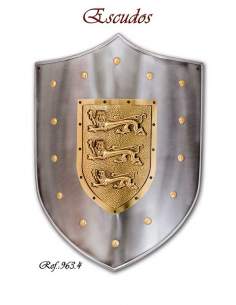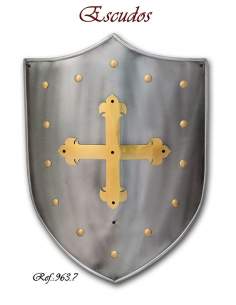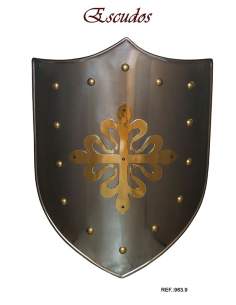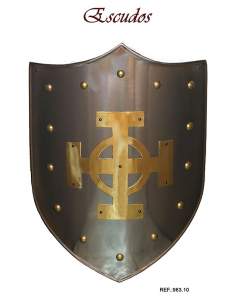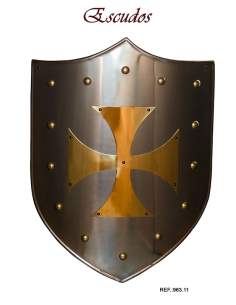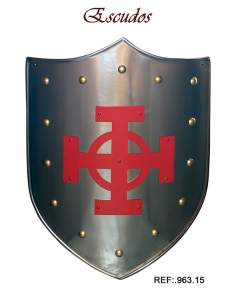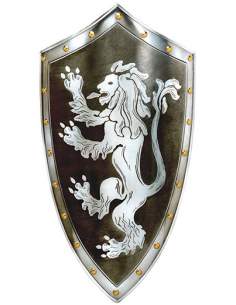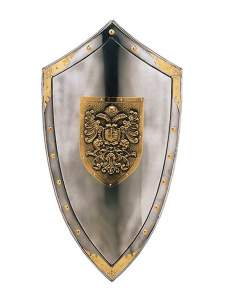Free shipping throughout Spain. International shipments to the whole world.
PERSONALIZED attention every day from 09:00 to 21:00
Shields

Medieval War Shields
The shield is considered one of the oldest weapons, which was used mainly for defense, but also for attack. As far as we know, the shield has been known for at least 5,000 years. The first finds that show its existence are found in the region of Mesopotamia and belonged to the Sumerian civilization. This weapon was so popular and effective that it was used until the 17th century, when it became obsolete due to the widespread use of firearms. Although today the shield is still used by the police in all countries of the world.
Normally, war shields were held with the left hand. In this way the warriors covered their entire body, and at the same time could use their right arm for counterattack.
The materials with which war shields were usually made depended greatly on the era. Thus, for example, the shields manufactured throughout the 3rd century BC. They were made of wood and wicker. Later they used leather and copper for their manufacture. In Ancient Greece they began to use linen and bronze, and already in medieval times, in addition to wood, steel and brass also began to be used for the creation and decoration of shields.
Not only the materials, but also the shape of this ancient weapon evolved over time. In more ancient times, war shields were usually circular in shape, while in the time of the Roman Empire they were semi-cylindrical, and later, medieval shields were oval shields.
Types of war shields
Broadly speaking, the following types of shields are distinguished:
· Abarga: oval-shaped shield, which is made up of two pieces of leather sewn together. It began to be used by the Muslim cavalry of Al-Andalus and continued to be used by Christian infantry and cavalry until the 16th century.
· Aspis: circular shield. It was made up of sheets of wood, which were glued together. The lower part of the shield was covered with leather. It was used by the ancient Greeks, who began using it in Minoan times and continued to do so until the 4th century BC.
· Buckler: bucklers were small circular medieval shields, made of wood, iron or steel. They had a cup in the middle to protect the hand that held it. They were used throughout the Middle Ages and even in the Renaissance.
· Clypeus: large circular shield. The structure of this type of shield could be made of wood and sometimes with intertwined willow branches. This internal structure of the shield was covered with multiple layers of metal sheets. The center usually had a protuberance that served to deflect enemy weapons and could also be used as a weapon. This type of shield was used by the ancient Greeks and Romans.
· Pavés: large shield with an extended rectangular shape. It was normally made of wood and covered with painted leather decorated with heraldic motifs. These medieval shields were used from the 11th century to the 15th century, although seafarers continued to use them for combat aboard galleys until the 17th century.
· Drop of water or tear: shield shaped like an elongated drop or tear. This shape significantly improved the protection of the front leg. It was made of wood. The period in which it was most used was between the 10th and 12th centuries.
· Rodela: lenticular war shield, which was used mainly for fighting with swords. It was a shield for training and duels. It was made of wood or steel. It was used since ancient times and until the Modern Age.
· Targe: round concave shield, traditional from Scotland, although its design was developed in Spain. It was made of iron or wood with plated iron. It was used from the 13th to the 16th century by the infantry.
· Tarja: concave medieval shields that were used to cover the entire body. They were made of wood and covered with leather. Over time, these war shields were made only of metals to achieve greater resistance. With some modifications, this type of shield was also used throughout the Middle Ages.
· Scutum: large semi-cylindrical shield, adapted to the natural shape of the human body. It was normally made of solid wood, although it was also made with a wooden frame covered with several metal layers. It was used by Roman legionaries until the 3rd century.
In this category, due to the further development of the aesthetics of war shields that took place in the Middle Ages, we mainly offer you medieval shields, although you can also find shields from older times.
Medieval Shields from the exclusive collection of "Historical Shields" manufactured by Marto.







